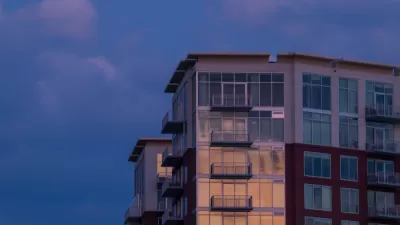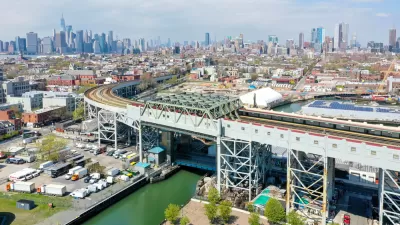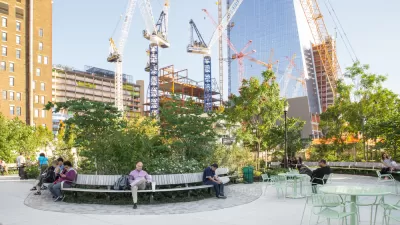In Zoned Out!, Tom Angotti, of City University New York (CUNY) tries to make the case against upzoning New York's neighborhoods (or at least its poorer ones).

Generally, economists and smart growth advocates tend to favor allowing new urban housing, while homeowners believe that new housing should always be located in someone else's neighborhood—thus earning the epithet "NIMBY" (for "Not In My Back Yard"). Historically, leftists have tended to agree with the experts and to oppose exclusionary zoning—but in left-wing, high-cost cities this is not always the case. In fact, "progressive NIMBYism" has some support among planning academics. In the new book Zoned Out! Race, Displacement, and City Planning in New York City, CUNY's Tom Angotti criticizes upzoning; he favors lots of new public housing for poor people, but it is not clear to me whether he favors any market-rate housing anywhere.
Angotti argues that new housing actually increases rents; he reasons that upzoning "increases the future value of land."(p. 29) and that as a result "new development drives up land values and rents in surrounding blocks and tenants in the buildings on those blocks can't affford to pay higher rents and are forced out." (p. 37). I critiqued this argument in a Planetizen blog post a couple of months ago. (If you don't feel like clicking on the link, here's my one-sentence summary: cities that have downzoned don't seem to be very successful in keeping rents down.)
Moreover, Angotti makes concessions that damage his argument. If upzoning is always bad, it logically follows that anti-density exclusionary zoning should lower housing prices and should be welcomed. But Angotti seems to oppose exclusionary zoning in the city's suburbs and outer boroughs. After discussing a wide variety of common zoning policies such as minimum lot size requirements, he notes correctly that "Zoning can be used ... to make it impossible to build housing affordable to low-income people" (p. 51). He also adds that such exclusionary zoning is not limited to the suburbs: New York's outer boroughs still have "predominantly white enclaves [that] continue to be protected by zoning" (p. 52). For example, Angotti complains that in Hasidic Boro Park, "[i]nstead of contemplating a rezoning that would encourage new higher density residential development—and possible racial change," (Id.) the city zoned to protect the status quo. Similarly, he notes that in affluent Park Slope anti-density zoning "protected... the relatively affluent white portion of the neighborhood" (Id.) And in Staten Island, a plan that "would have brought higher-density development to the low-density white borough ... was rejected [due to racial fears]" (p. 55). So it seems to me that Angotti believes that 1) in middle-and upper-class white areas, restrictive zoning keeps property values high and blacks and Hispanics out while and 2) in racially diverse areas, restrictive zoning is necessary to keep property values low. I am not sure how both these propositions can be true.
Having said that, Angotti's arguments are tethered to factual reality in one important respect: it is true that in some rapidly gentrifying areas, upzonings were followed by rent increases far exceeding those of citywide levels. (Angotti focuses on Williamsburg, Harlem and Chinatown.) So based on this data set, he concludes that upzoning leads to rent increases which leads to displacement. These cases certainly present a challenge for market urbanists—but it seems to me that there is more than one possible explanation for this phenomenon.
For one thing, New York's 2000s upzonings were accompanied by downzonings—sometimes even in the same neighborhood as the upzonings. For example, much of Williamsburg was upzoned in 2005—but in 2008, the city downzoned higher-income blocks (p. 91). So the overall effect of rezonings on housing supply is unclear.
Moreover, New York's combination of upzonings and downzonings might have caused localized rent spikes that would not have occurred in a more consistently pro-development city. If a city says (in so many words) "in zone A you can't build anything new, while in zone B you can build new stuff," housing demand from the people excluded from zone A might flood into zone B. So even if supply in zone B increases, so does demand—and, of course, so do land costs, as would-be landlords bid up the price of B's scarce land. So it seems to me that if upzoning in one place causes rent spikes, upzoning everywhere is more likely to contain rents than downzoning everywhere.
Even the correlation between gentrification and displacement is a bit more wobbly than Angotti thinks. He notes that between 2000 and 2013, the black population of one part of Harlem decreased by 5 percent (p. 111). But Harlem has been losing blacks for many decades. In 1950, Central Harlem had about 230,000 blacks; in 1990, Harlem had just under 90,000. (Details can be found here.) Gentrification may displace minorities—but poverty displaces even more, as people flee from declining neighborhoods. (Similarly, declining cities such as Detroit tend to have declining black populations, as all but the poorest flee to suburbia.)
Angotti's ultimate remedy to New York's affordability problems is unclear. The last chapter of his book endorses increased public housing construction and something called "community planning"—that is, increasing neighborhoods' veto power over new development. Since neighborhood activists often oppose new housing near them, I suspect that the latter policy would eliminate new market-rate housing in New York—which Angotti might (given his assumptions about land prices) view as a desirable result.

Alabama: Trump Terminates Settlements for Black Communities Harmed By Raw Sewage
Trump deemed the landmark civil rights agreement “illegal DEI and environmental justice policy.”

Planetizen Federal Action Tracker
A weekly monitor of how Trump’s orders and actions are impacting planners and planning in America.

The 120 Year Old Tiny Home Villages That Sheltered San Francisco’s Earthquake Refugees
More than a century ago, San Francisco mobilized to house thousands of residents displaced by the 1906 earthquake. Could their strategy offer a model for the present?

Ken Jennings Launches Transit Web Series
The Jeopardy champ wants you to ride public transit.

BLM To Rescind Public Lands Rule
The change will downgrade conservation, once again putting federal land at risk for mining and other extractive uses.

Indy Neighborhood Group Builds Temporary Multi-Use Path
Community members, aided in part by funding from the city, repurposed a vehicle lane to create a protected bike and pedestrian path for the summer season.
Urban Design for Planners 1: Software Tools
This six-course series explores essential urban design concepts using open source software and equips planners with the tools they need to participate fully in the urban design process.
Planning for Universal Design
Learn the tools for implementing Universal Design in planning regulations.
Clanton & Associates, Inc.
Jessamine County Fiscal Court
Institute for Housing and Urban Development Studies (IHS)
City of Grandview
Harvard GSD Executive Education
Toledo-Lucas County Plan Commissions
Salt Lake City
NYU Wagner Graduate School of Public Service






























